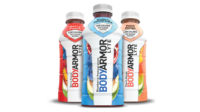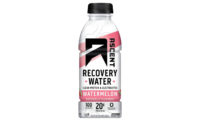2022 State of the Beverage Industry | Sports, protein drinks adapt to the market alongside functional beverages
Low- and no-calorie, natural and organic releases drive innovations

As the sports and protein drinks category contend with the new age beverage marketplace, experts note that it has adapted to the market alongside functional and hybrid beverages.
“Performance of sports and protein drinks are super strong,” noted Sally Lyons Wyatt, executive vice president at Information Resources Inc. (IRI), Chicago, in Beverage Industry’s May eMagazine.
“From an omnichannel perspective, we have seen double-digit growth in dollars and in units, “Wyatt said. “Both online and in-store are contributing to the growth.
“When COVID-19 hit, and we were at home more with gyms closed, we saw sports and protein drinks decline in sales. However, [the category] quickly rebounded as mobility picked up and people began to work out more,” she continued. ”In addition, hybrid working models have fueled growth of these drinks.”
According to IRI data, sports drinks generated dollar sales of $9.9 billion, a 17.8% year-over-year (YoY) increase for the 52 weeks ending May 15, in total U.S. multi-outlets. Meanwhile, unit sales increased 1% YoY for the same time-period, IRI data shows.
|
|
DOLLAR SALES | % CHANGE vs PRIOR YEAR | MARKET SHARE | % CHANGE vs PRIOR YEAR | |
| 1 | Gatorade | $6,247,502,199 | 10.1 | 65.08 | -3.44 |
| 2 | BODYARMOR | $1,648,605,199 | 39.9 | 17.17 | 2.94 |
| 3 | Powerade | $1,255,907,038 | 3.4 | 13.08 | 1.57 |
| 4 | Electrolit | $296,268,046 | 107.6 | 3.09 | 1.4 |
| 5 | Private Label | $54,771,476 | 67.1 | 0.57 | 0.17 |
|
|
Category Total* | $9,599,996,014 | 15.9 | 100 | --- |
*Includes brands not listed
Source: Information Resources, Inc. (IRI), Chicago. Total U.S. supermarkets, drug stores, gas and convenience stores, mass merchandisers, military commissaries, and select club and dollar retail chains for the 52 weeks ending May 15.
Jacqueline Hiner, senior technical analyst at New York-based IBISWorld, noted in Beverage Industry’s May eMagazine that overall, functional beverages as a whole have been on the rise, including sports and protein drinks.
As the more traditional sports and protein drinks remained popular among individuals active in sports and weightlifting, “new hybrid beverages, such as ready-to-drink caffeinated protein drinks, and other health-toting concoctions, have debuted over the past several years and garnered a significant level of attention,” Hiner explained.
Whereas the category was essentially a two-player market for a long time, “it has definitely had to reinvent itself in this blurred beverage marketplace,” IRI’s Wyatt added.
As sports and protein drinks have contributed more than its fair share to the [liquid refreshment beverage] (LRB) dollar growth; “this growth has purely come from low/no-calorie options and innovations,” Wyatt said in Beverage Industry's May eMagazine.
“They do have high interaction indices with flavored still water brands,” she explained. “The post- and during- workout is a key occasion for a lot of functional waters and these low-calorie sports drink options serve as a good substitute for those occasions, thereby stealing share from some functional beverages.”

As consumers give more consideration to remaining healthy, the functional beverage is expanding in the sports drinks market at a quick rate, notes Hyderabad, India-based MarketDataForecast’s report titled “Sports Drink Market Growth and Forecast (2022-2027).”
According to the report, the global sports drink market size was valued at approximately $24 billion in 2021 and is likely to reach an estimated $32 billion by 2027, garnering a compound annual growth rate (CAGR) of above 4% during the forecast period 2022-2027.
“In the developed markets, drinks are never again seen as a brisk refreshment,” the report states. ”They have become progressively helpful supplements and food supplement items. The purchaser sections driving the development of the market incorporate maturing buyers searching for essentials, 20- to 30-year-olds eager to attempt new items with well-being benefits, and occupied buyers looking for ‘snappy wellbeing.’
“In 2018, the North America sports drinks market held the largest share of about 40% in terms of revenue,” it continues. “The growth in this regional market is owing to the growing trend of athleticism and rising concerns over health. The recent changes in consumer lifestyle have resulted in the need for a healthy diet, which is likely to augment the business growth in this area.”
Adding to the performance drink options, Boca Raton, Fla.-based Celsius Holdings Inc. released its newest flavor: CELSIUS Sparkling Strawberry Lemonade. Made with clinically proven ingredients, this new carbonated flavor of CELSIUS LIVE FIT provides essential energy while it accelerates metabolism and burns body fat, the company says.
|
|
DOLLAR SALES | % CHANGE vs PRIOR YEAR | MARKET SHARE | % CHANGE vs PRIOR YEAR | |
| 1 | Ensure | $765,682,869 | 6.5 | 14.02 | -1.83 |
| 2 | Premier | $699,943,051 | 17.5 | 12.82 | -0.32 |
| 3 | Boost | $433,901,832 | 12.7 | 7.94 | -0.55 |
| 4 | Celsius | $405,151,968 | 193.9 | 7.42 | 4.38 |
| 5 | Private Label | $363,275,260 | 12.2 | 6.65 | -0.4 |
|
|
Category Total* | $5,461,491,187 | 20.4 | 100 | --- |
*Includes brands not listed
Source: Information Resources, Inc. (IRI), Chicago. Total U.S. supermarkets, drug stores, gas and convenience stores, mass merchandisers, military commissaries, and select club and dollar retail chains for the 52 weeks ending May 15.
As the blurring of LRBs continue, the sports drink industry will be pressured to differentiate benefits in order to capitalize on its current growth trajectory, IRI’s Wyatt noted in Beverage Industry’s May eMagazine.
“These benefits include expansion of the health and wellness benefits, as well as ensuring broad distribution across brick-and-mortar channels and online so the products are available for consumer’s hybrid ways of working,” Wyatt said. “In addition, flavor innovation will be important especially for their brand loyal[ist]s.”
Moreover, as natural and organic ingredients have increased in the beverage space, a variety of health and wellness benefits continue to emerge within the sports and protein drinks category, experts note.
“Examples include products that provide immunity by containing potassium and magnesium; digestive health claims; bone and joint health claims; brain health and arthritis health claims,” Wyatt noted in Beverage industry’s May eMagazine. “From a sustainability perspective, sustainably certified is emerging with strong unit and dollar sales as well.”
While natural and organic products have been around for a while, plant-based ingredients are expected to drive growth for the industry moving forward, IBISWorld’s Hiner noted in Beverage Industry’s May eMagazine.
“The biggest emerging trend for protein drinks, in particular, is the growing popularity of plant-based beverages,” she explained. “This comes alongside a wider trend toward plant-based diets and the expansion of plant-based foods.”
As natural and organic ingredients have increased, sports and protein drink producers “have either incorporated these ingredients directly into their own beverages, launched new product lines aimed specifically at this demographic, or acquired pre-existing players within the industry to earn an early stake within the rapidly growing market,” Hiner noted.
“As with the broader beverage industry, functional beverages are expected to continue to expand, with consumers opting for sports and protein drinks with the most added benefits,” she concluded.
Looking for a reprint of this article?
From high-res PDFs to custom plaques, order your copy today!







